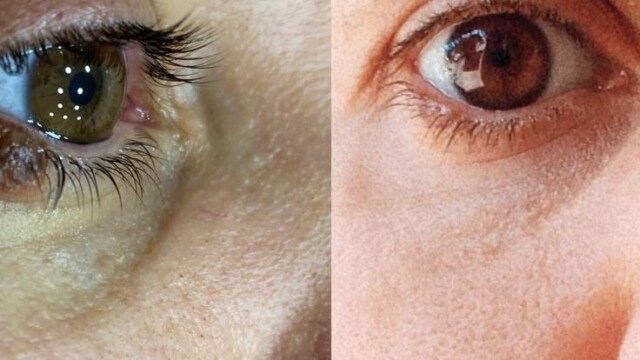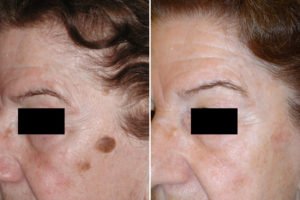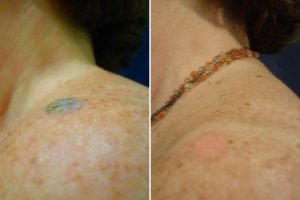Seborrheic Keratosis Treatment
Conventional treatments are based on the local destruction of the tissue:
- Cryosurgery (tissue freezing) is an effective but very painful treatment and leaves damage to the treated area that takes a long time to recover.
- Electrocoagulation generates, like cryosurgery, a lot of tissue destruction, a long recovery time and the possibility of leaving scars.
- Surgical treatment.
- Laser treatment.
In Hoogstra Medical Centers we treat keratoses with the Erbium Lotus II laser.
He Lotus It impacts the keratosis at high speed, generating no pain for the patient or damage to neighboring tissues. Leaves no scars.
Large keratoses are generally removed in more than one session.
After each session no special care is required and the patient immediately resumes his activity.
Seborrheic Keratosis Treatment Cost
El costo por cada sesión de Láser Lotus es de $80.000.
The number of sessions depends on the amount and size of the keratoses.
Generally, between 1 and 3 sessions are carried out.
The interval between one session and the other is 7 to 15 days.
If there are many, more than one session can be done in the same day.
This procedure is performed by dermatologists at the 3 centers.
You can take your turn online WITH DERMATOLOGISTS at any of our branches and attend directly to carry out a treatment.
How do I take a shift?
The most effective, safe and practical way to take a shift is via the internet.
You can take a turn and go directly to perform a treatment. If you have any questions, you can clarify it first with the same professional.
The cost of the dermatological consultation is $20,000 pesos, if you. carry out the treatment then the value of the consultation will be discounted.
If you. If you have any medical questions, you can write to us in advance by sending an email to
Only medical consultations will be received here. This mail does not address inquiries about shifts, payments and administrative issues.
Clinical picture
Actinic keratoses develop most commonly in the parts of the body that are most exposed to the sun, such as the face, ears, neck, hands, or forearms.
They are usually painless, but can be irritated and itchy. Keratosis presents clinically as rough, scaly patches or lesions.
These spots or lesions are not carcinogenic, but if left untreated they can potentially develop into a serious type of skin cancer called squamous cell carcinoma.
What are the symptoms of actinic keratosis?
Actinic keratosis looks like a pink, brown, or skin-colored spot that is bulky and rough to the touch.
What causes actinic keratosis?
The biggest cause of actinic keratosis is too much sun exposure (natural light like the sun, or artificial light like that of the solarium).
Who is at risk of getting actinic keratosis?
It is more frequent in patients with fair skin, blue eyes of middle age or older who have had a lot of sun exposure.
How is actinic keratosis diagnosed?
People who are at risk of having any skin disorder should check their skin regularly. If you notice any persistent lumps or spots of unusual color, texture, shape, or size, you need to contact a doctor or dermatologist. Other worrying signs are pimples that don't heal or anything else that bleeds easily. The doctor will likely biopsy the skin by removing part or all of the lump to check for cancer cells.
How is actinic keratosis treated?
In most cases, actinic keratosis can be treated and cured. The result is more favorable if the disease is detected in its early stages. Treatment options include the following:
• Topical creams or lotions
• Cryosurgery (freeze it)
• Electro-surgery (use of an electric current)
Treatment
Our Centers are equipped with the most advanced technology. The most modern treatment today is the exfoliation with the Lotus II Laser, Erbium micro fractionated. It is painless, fast, does not leave scars and the patient immediately continues his social activity.
It does not require the use of anesthesia of any kind, since the laser impact on the tissue is so fast that it does not cause pain or discomfort, allowing the treatment of multiple and large lesions.
How can actinic keratosis be prevented?
The best way to prevent actinic keratosis is to reduce sun exposure, especially during the hours when the sun is at its highest and the light is most intense. Some tips to keep in mind:
- Wear long-sleeved shirts, long pants, and a hat to protect areas of the skin that may be exposed to the sun.
• Apply sunscreen with a sun protection factor (SPF) of 30 or higher at least 30 minutes before going outside. A broad spectrum sunscreen is recommended to protect the skin from both A and B ultraviolet rays.
• Avoid tanning by staying in the sun or using solariums; it is preferable to use self-tanning products
- Lotus Laser Seborrheic Keratosis Treatment Results:
Patient testimonial
We invite you to watch the videos on our YouTube channel with the account of patients who have received this treatment, entering here: Keratosis






